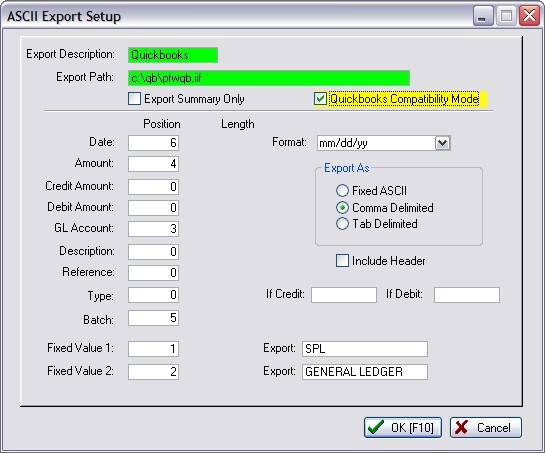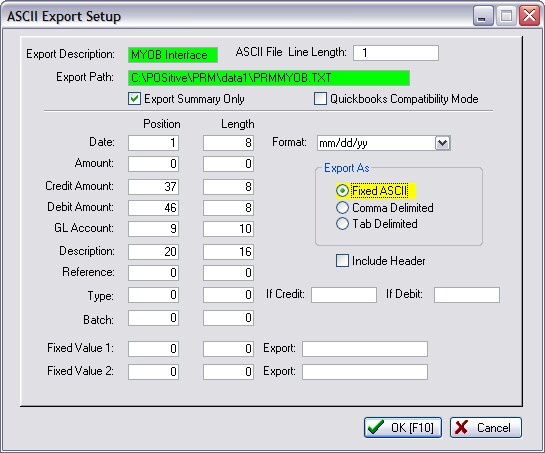Overview
This setup is optional. Its purpose is to transfer GL numbers from POSitive to an accounting program such as Quickbooks or MYOB. Once the setup is complete, the transfer can be automated.
NOTE: Rather than using this automated system, some businesses prefer to manually enter the totals into their account package, thereby giving them more control over the process.
After processing the POSitive Export, POSitive will copy the batch data into an ascii export file. You then follow your accounting software program's instructions for importing the ascii file. The GL totals will be added to your accounting software program.
Quickbooks GL Export Setup
Because Quickbooks Pro and Professional are commonly used accounting packages, here are the settings for the export.

Advance Setup
You must understand your accounting software program's requirements for the import file. Generally, the accounting software program will expect various elements to be in a specific sequence and this screen allows you to define the sequencing.
The elements of a record are kept in a "string" and the sequence of the elements is critical.
To help you understand this concept, visualize a freight train consisting of several different kinds of railroad cars. These cars are named: Date, Amount, Credit Amount, Debit Amount, GL Account, Description, etc.
Each car has a specific length, Date=8 characters, Amount=10 characters, Credit Amount=6 characters, etc.
The sequence of the cars is determined by it's "position" number in the string.
Comma or Tab Delimited Setup
This is the easiest setup. All you need to know is the sequence of items,
In the following example, the accounting program knows that the Date starts the "string" of information followed by GL Account and then the Description, etc

Fixed ASCII Setup
With Fixed ASCII, you also need to know the length of the element and calculate at what point in the string that it will stop. In the following example, the accounting program knows that the Date starts the "string" of information followed by GL Account and then the Description, etc
1234567890123456789012345678901234567890123456789012345....
Date-------GL Account--Description-------------CreditAmt-DebitAmt--Reference.....
(The bold 0 is the tens marker.)
Date 8 characters, starts at 1 ends at 8
GL Account 10 characters starts at 9 ends at 19
Description 16 characters starts at 20 ends at 36, etc.
NOTE: You MUST know what elements and sequence of elements are required by your accounting software program before you can continue.

Setup
Export Description - enter a name for this setup definition.
ASCII File Length - the maximum length of each record. Typically 144 characters is used.
Export Path - the drive letter, directory, and file name where the generated information will be saved. For example c:\accounting\import.txt.
Export As
Choose the type of file layout required by your accounting package.
Fixed ASCII - one long string of text with spaces filling the gaps between data
Comma Delimited - data separated by commas
Tab Delimited - data separated by tab characters
Name - the name of the element
Position - the starting character's position in the "string" of data
Length - the number of characters required for the data element
The following elements are typically expected as part of the import file.
Date - the date of the transaction.
Date Format - The date will be written in the style selected.
Amount - the amount of the transaction
Credit Amount - the value to be applied as a credit
Debit Amount - the value to be applied as a debit
GL Account - the GL Account number/name as defined in your chart of accounts
Description - the label or explanatory text of the GL Account
Reference - the invoice or transaction reference number
Type - A designator or code for transaction type. Enter the designator for credit and debit transactions.
If Credit -
If Debit -
Fixed Value 1 -
Fixed Value 2 -
Some accounting packages expect a beginning and ending marker for each string (the locomotive and caboose) and you can enter the designator or code to be used as these fixed values.
Position
This is only necessary when you are doing a Fixed ASCII setup. When you are setting positions, be sure that data from one field will not overlap into data from another field.
For example if the GL Acccount starts at position #9 and is 10 characters long it will end at position #18. Do not start the next element in the middle, say at position #15. This will cause truncation and misreporting of data.
1234567890123456789012345678901234567890123456789012345....
Date-------GL Account--Description-------------CreditAmt-DebitAmt--Reference.....
When you are finished, click OK. You may edit this setup as often as needed.